Sasha Cottman's Blog, page 2
September 21, 2014
Perfect Roast Potatoes
Published on September 21, 2014 03:42
September 6, 2014
Bread & Butter Pudding
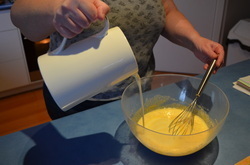 This recipe dates from John Nott first published in 1723.
This recipe dates from John Nott first published in 1723.Ingredients.
20 slices of bread. Stale bread is good.50g each of currants, raisins and chopped dates. (or cheat like I did and use fruit loaf)1 litre of single cream.130g sugarButter (or margarine)1 tbs Brown sugar6 egg yolksMace & Nutmeg & SaltMethod.
In a heavy based saucepan (I used a normal one) simmer the cream for 4 mins. Make sure it does not boil. Whisk in a pinch of salt and 1/4 teaspoon each of mace and nutmeg. After this simmer the mix for another 4 mins, then take it off the heat and allow to cool. Pre heat the oven to 180 degrees.
In a large mixing bowl whisk the egg yolks and sugar together. When the cream mix is cool slowly add it to the mix. Make sure the cream mix is cool otherwise you will scramble the eggs.
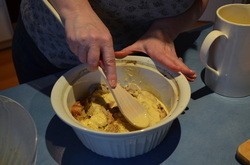 Butter the bread on both sides and using a wooden spoon (or your clean fingers) push 1/3 of the bread down into an oven proof dish. Poor 1/3 of the egg and cream mix over the bread. Repeat until all the mix is in the bowl. Then sprinkle brown sugar over the top and add a nob or two of butter. Pop the baking dish in the oven for an hour.
Butter the bread on both sides and using a wooden spoon (or your clean fingers) push 1/3 of the bread down into an oven proof dish. Poor 1/3 of the egg and cream mix over the bread. Repeat until all the mix is in the bowl. Then sprinkle brown sugar over the top and add a nob or two of butter. Pop the baking dish in the oven for an hour.Technically speaking you should take it out the oven, wait for another 30 minutes and then be able to turn this over and pop it out like a cake. If your family is anything like mine, as soon as it comes out of the oven they will be standing with bowls and spoons at the ready. Be careful as the bread and butter pudding will be hot. Enjoy!

Published on September 06, 2014 20:27
May 27, 2014
Back in the Regency Kitchen - Scotch Eggs
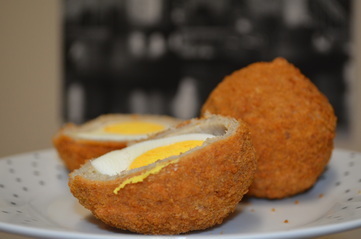 Fortnum and Masons the famous department store in London has long claimed to have invented Scotch Eggs in the 18th Century, but many disagree and say it is a traditional Scottish dish. Either way, they are delicious hot,but especially good cold and are great for picnics
Fortnum and Masons the famous department store in London has long claimed to have invented Scotch Eggs in the 18th Century, but many disagree and say it is a traditional Scottish dish. Either way, they are delicious hot,but especially good cold and are great for picnicsIngredients 5 eggs
250g sausage meat (good quality) 2 tbs of fresh chopped herbs
½ teaspoon of either mace or nutmeg 2tbs plain flour
80 g breadcrumbs Salt and pepper
Oil to fry the eggs.
Method
Hard boil 4 of the eggs and remove shell.
Put the sausage meat, breadcrumbs and the cracked 5th egg in separate bowls.
Mix the sausage meat, herbs, mace together and divide into 4 separate portions.Roll the shelled eggs in a mixture of the flour, salt and pepper.
Flatten the sausage meat mix and then wrap them around the eggs so you have 4 eggs wrapped in the sausage mix. Beat the 5th egg and roll the wrapped eggs in it. Finally roll the eggs in the breadcrumbs. You are now ready to fry the eggs.
Fry the eggs in the oil for 8-10 minutes and then let them sit on some kitchen paper for the oil to drain away. You can eat them hot or leave them to go cold and store them in the fridge.
Published on May 27, 2014 02:55
July 25, 2013
Win a copy of Letter from a Rake
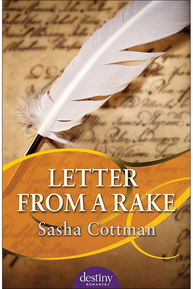 For Friday 26th of July 2013, I am visiting fellow author Leisl Leighton's Blog and offering a chance to win a copy of Letter from a Rake from those who leave a comment on Leisl's blog.
For Friday 26th of July 2013, I am visiting fellow author Leisl Leighton's Blog and offering a chance to win a copy of Letter from a Rake from those who leave a comment on Leisl's blog. Come say hi and hopefully you will be the lucky winner.
http://www.leislleighton.com/?p=252
Published on July 25, 2013 20:58
July 7, 2013
The Regency Kitchen - Roast Chicken with Egg Sauce
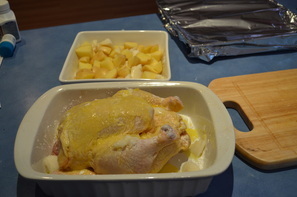
This week I decided to try a good old
fashioned Sunday roast, Regency style.
The recipe for Roasted Chicken with Egg
Sauce comes from The Experienced English
Housekeeper, 1786.
Ingredients.
1 good sized roasting chicken. Mine was
about 1.5kg or approx. 3lbs. 2 X 125g of butter. I bought a block of butter and cut it as I needed it. 5 tbsp plain flour. Gravy mix. I cheated and used instant gravy, but feel free to boil up the neck and gibblets and make gravy from scratch.2 hard boiled eggs.
Vegetables for the roast. My husband only demands the following for roasts. Potatoes, parsnip, carrot, broccoli, brusselsprouts, cauliflower, pumpkin & onion. He is a simple chap who thinks Christmas lunch must have at least 7 different meats. Duck fat (if you can find it, usually in the butter section of the supermarket). I have seen too many Jamie Oliver shows and thought I would put this in with the chicken and roast potatoes.
Method. Take 3 tbsp of the flour and after sifting it (or not…no I didn’t ) sprinkle it over the chicken. Melt 125g of butter (approx. ½ a pound) and pour this over the flour. Next time I will put some dry herbs into the flour. Put some of the duck fat around the chicken. Cut up one of the onions into quarters and put inside the chicken.(you could use stuffing if
you wanted instead). Put the chicken (uncovered) in the oven for the usual time you would roast a chicken. Around 218C/425F for an hour and 20 mins.Cut up the potatoes and put a few dollops of the duck fat in with them. Put
them in the oven. I put them down on the bottom of the oven and move the tray up with the chicken later.Cut up the rest of your vegetables. I put the pumpkin, parsnip ,carrot and another onion in a roasting pan, covered them with foil and then put them in the oven about 30 mins after the chicken and potatoes went in. When the chicken is 10 mins from being ready, take the foil off to allow the onion to brown (it is a criminal offence in our house not to burn the onion on the top). The broccoli, cauliflower and brussel sprouts I steamed on the stovetop. Cut the chicken up, serve the vegetables and make the gravy. Put the egg sauce on top of the chicken.
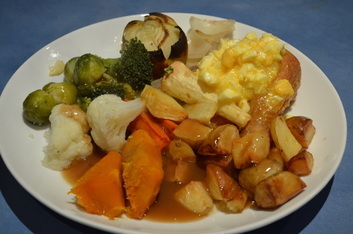
The Egg Sauce.
Boil the 2 eggs and let them cool a little.
Cut them open and slice up the egg white (roughly). Then take a fork and flake
the egg yolk. Mix them together in a gravy boat or a bowl. When you have the
chicken and the vegetables all cooked and ready to be served, melt another 125g
of butter and mix this in with the eggs. You can put a couple of tbsp of flour into the mix at this point to thicken the sauce. Spoon the egg sauce over the meat. (make sure you do this when the butter is warm).
Published on July 07, 2013 01:04
June 22, 2013
The Regency Kitchen - Easy Apple Dumplings
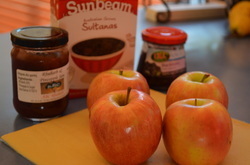 After the surprising success of our first attempt at Regency cooking, we decided to venture back into the kitchen. This recipe for apple dumplings comes from The Experienced English Housekeeper,1789.
After the surprising success of our first attempt at Regency cooking, we decided to venture back into the kitchen. This recipe for apple dumplings comes from The Experienced English Housekeeper,1789.Ingredients
For making the pastry you can either use these ingredients or buy pastry sheets.
8 oz (250g) flour, 1 egg yolk, 4 oz (125g) butter, or butter and lard, A pinch of salt.
4 good eating apples. Cream, or custard to serve. We used vanilla custard.
4 tsp marmadale, or sultanas, or jam or sugar and cinnamon. We used sultanas and cinnamon in one dumpling and blackberry conserve in the others. You could use any sort of sweet filing.
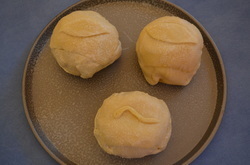 Method.
Method.Preheat the oven to 400F/200C/Gas Mark 6. Make the pastry or get
the frozen pastry sheets out of the freezer. Divide the pastry into 4 equal portions and roll them out thin. This is why I used pastry sheets.
Peel and core the apples. If you don’t have an apple corer, you
could cut the apple in half, cut out the seeds etc and then put the apple
together again when you wrap the pastry around it. I did try to core the first apple with a sharp knife but made such a mess that only 3 apples made it into the oven.
Lay each apple on the pastry, allowing the pastry to come up a little more than halfway up the apple. Put the filing inside the apple. Cut a small square of pastry to go over the top. I smoothed the pastry joins etc with a little warm water and clean fingers. The leaves and worm were an added decoration.
Spray an oven tray with some baking spray and a little on the top
of the pastry to help it brown. Bake in the oven for 35-40 minutes and serve hot.

Published on June 22, 2013 20:57
June 10, 2013
Disasters from the Regency Kitchen.No 1
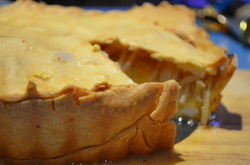 Firstly, a confession, I am hopeless in the
Firstly, a confession, I am hopeless in the kitchen. If you invite me to your house for dinner, be grateful that I bring wine and cheese.
So with that in mind, I decided to embark
on the foolish task of cooking some of the recipes I have come across in my historical romance writing research.
Onion Pie.
This is actually a recipe which dates from the 1747 publication The Art of Cookery made plain and easy. Even in the 18th Century, you ran the risk of getting a cookbook for
Christmas.
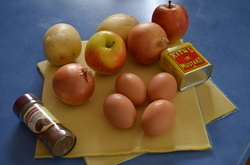 Ingredients.
Ingredients.750g (1 ½ lb) shortcrust pastry. I cheated and bought pastry sheets.
2 medium potatoes, 2 medium onions, 2
apples. I used red apples.
60g (2oz) butter. 4 tbs water.
½ tsp mace. I struggled to find this in the supermarket, so I used Keen’s mustard instead which has been around since that time. (Well the tin in my cupboard has been). A little ground nutmeg. Some pepper, 1 tsp salt. 4 hard-boiled eggs, sliced.
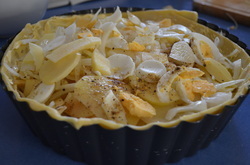 Method.
Method.Heat the oven to 350F/175C/Gas Mark 4. I
did put the fan force on and turned it down a
little. Boil the eggs. While they are boiling, peel the potatoes, onions and apples and thinly slice them.Line a 9 inch pie dish with half the pastry. I cut the sheets up and made them fit. Beat the butter with a wooden spoon and then spread half of it over the pastry. Mix the spices together. Sprinkle a little over the pastry. Then layer the sliced eggs, potatoes, onions and apples in the dish, sprinkling a little of the spice between the layers. Roughly cut is good enough remembering that they didn’t have egg slicers in those days. (Ok, I couldn’t find one in my kitchen). Cut the rest of the butter into pieces and lay them on the top. Put in the 4 tbs of water. Then put the pastry sheet on the top.
Cook for an hour or until the potatoes are tender. Serve hot or cold.
You could make these into individual onion pies.
Published on June 10, 2013 01:58
May 25, 2013
A Regency gentleman and his boot
Her eyes drifted lower to the highly polished black Hussar boots which clung to his calf muscles. She took a deep breath and tried to turn her head away, but found herself unable.
Or was it unwilling?
Letter from a Rake.
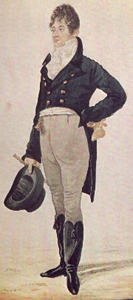 The military uniforms of European countries such as Prussia, France and Russia, had a great influence on English mens fashion in the 19th century. The boot was a practical solution to the poor condition of the roads and a gentleman’s need to ride.
The military uniforms of European countries such as Prussia, France and Russia, had a great influence on English mens fashion in the 19th century. The boot was a practical solution to the poor condition of the roads and a gentleman’s need to ride.
The Hessian boot (a favourite of Mr George Brummell)
The most popular type of boot was the Hessian. Originally, they were designed as a hard working leather boot for military officers. Having a low heel and a pointed toe, they were particularly suited to sit easily in the stirrup.
With a heart- shaped top and decorative tassel (gold for fashion and silver for mourning), they were a comfortable and practical form of footwear.
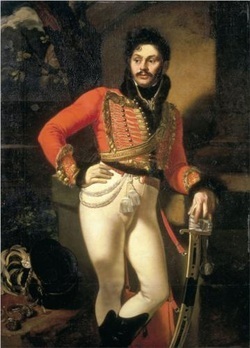 The Hussar boot.
The Hussar boot.
The Hussar (or buskin) boot was a variation on the very popular Hessian boot. They were short calf- length Hessians, but without the decorative tassel.
Colonel E Davydov. Prussian Hussars 1809
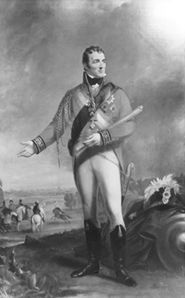 The Wellington boot.
The Wellington boot.
Another famous variation on the Hessian boot, which still survives in various forms today, was the Wellington boot. The Duke of Wellington had his boot maker, Hoby of St James’s Street London, change the boot so that the top reached to knee high in front. He also had the back lowered to make the boot more comfortable. The story being, that Wellington had noted the number of injuries sustained by his mounted soldiers from having been shot in the knee.
The higher front on the Wellington (without a turnover cuff) afforded at least a modicum of cover. The Wellington was cut to a loose fit and soon gained in popularity.
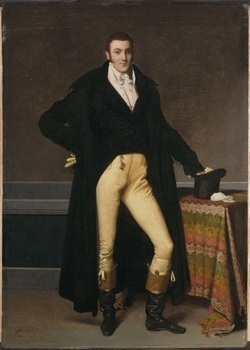 The Top Boot.
The Top Boot.
The top boot (or hunt boot) had a cuff at the
top. The inside of the boot was made of lighter color leather and was often turned down to give a stylish two tone effect. Some boots were made with a separate tan top to give the impression of a ‘turned down’ boot.
Portrait of Joseph Antoine de Nogent
Copyright. www.harvardartmuseums.org
Or was it unwilling?
Letter from a Rake.
 The military uniforms of European countries such as Prussia, France and Russia, had a great influence on English mens fashion in the 19th century. The boot was a practical solution to the poor condition of the roads and a gentleman’s need to ride.
The military uniforms of European countries such as Prussia, France and Russia, had a great influence on English mens fashion in the 19th century. The boot was a practical solution to the poor condition of the roads and a gentleman’s need to ride.The Hessian boot (a favourite of Mr George Brummell)
The most popular type of boot was the Hessian. Originally, they were designed as a hard working leather boot for military officers. Having a low heel and a pointed toe, they were particularly suited to sit easily in the stirrup.
With a heart- shaped top and decorative tassel (gold for fashion and silver for mourning), they were a comfortable and practical form of footwear.
 The Hussar boot.
The Hussar boot.The Hussar (or buskin) boot was a variation on the very popular Hessian boot. They were short calf- length Hessians, but without the decorative tassel.
Colonel E Davydov. Prussian Hussars 1809
 The Wellington boot.
The Wellington boot.Another famous variation on the Hessian boot, which still survives in various forms today, was the Wellington boot. The Duke of Wellington had his boot maker, Hoby of St James’s Street London, change the boot so that the top reached to knee high in front. He also had the back lowered to make the boot more comfortable. The story being, that Wellington had noted the number of injuries sustained by his mounted soldiers from having been shot in the knee.
The higher front on the Wellington (without a turnover cuff) afforded at least a modicum of cover. The Wellington was cut to a loose fit and soon gained in popularity.
 The Top Boot.
The Top Boot.The top boot (or hunt boot) had a cuff at the
top. The inside of the boot was made of lighter color leather and was often turned down to give a stylish two tone effect. Some boots were made with a separate tan top to give the impression of a ‘turned down’ boot.
Portrait of Joseph Antoine de Nogent
Copyright. www.harvardartmuseums.org
Published on May 25, 2013 20:33
May 4, 2013
Regency Writing Desks
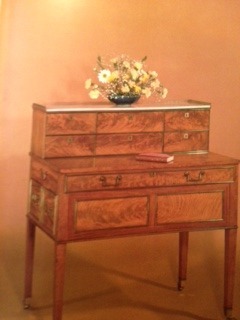 Expense was no object to the refined members of Regency English society when it came to their writing desks. Mahogany timber, brass mouldings and exquisite craftsmanship was the order of the day. The brass castors allowed the desk to be moved easily, without scratching highly polished floorboards.
Expense was no object to the refined members of Regency English society when it came to their writing desks. Mahogany timber, brass mouldings and exquisite craftsmanship was the order of the day. The brass castors allowed the desk to be moved easily, without scratching highly polished floorboards.While ladies spent a great deal of their time writing letters during the
day, a woman of quality and fine breeding would have a small satinwood writing
table for her bedroom or boudoir.
I can imagine Millie Ashton, heroine of Letter
from a Rake sitting at this very desk penning a note to a friend in far off Calcutta,
India.
1790 mahogany bonheur-du-jour
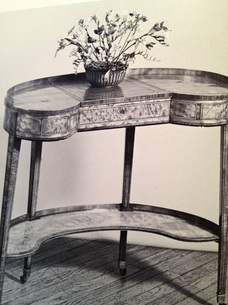 Satinwood kidney table, suitable for a ladies bedroom or boudoir
Satinwood kidney table, suitable for a ladies bedroom or boudoir
Published on May 04, 2013 20:28


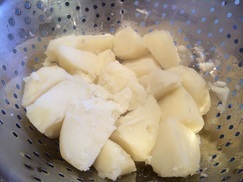 She cut a piece of roast potato in half and put it into her mouth. Cooked long in goose fat, it was delicious. She sat chewing, savouring the caramelised crust while listening to the buzzing conversation which continued unabated around her. Was there anything better than a well-cooked potato?
She cut a piece of roast potato in half and put it into her mouth. Cooked long in goose fat, it was delicious. She sat chewing, savouring the caramelised crust while listening to the buzzing conversation which continued unabated around her. Was there anything better than a well-cooked potato?

